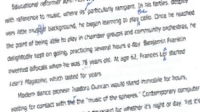Whether consumers or
business buyers, people today are skeptical
and tight with their discretionary money. If
customers have been slow to sign up for your
paid offerings, try these practical
copywriting exercises to increase the
persuasive power of your marketing pitches.
1. For your company, think
up reasons why people might think you're not
good enough to deserve their business.
Explain why those are, on the contrary,
excellent reasons to buy from you.
2. Estimate your company's
positivity score by giving yourself one
point for every upbeat, sunny-side-up web
page, article, blog post, etc. and one minus
point for each instance of complaining,
criticism, gloom or loathsomeness. After
adding everything up, you should normally
arrive at a solidly positive number. If not,
make plans to shift your tone.
3. Find factual statements
that you've written as if their significance
to the customer is obvious. Give each such
statement the "So what?" treatment. Ask "And
what's good about that?" or "Why is that a
good thing?" If your answers clarify the
appeal of your statement, flesh out what you
had written with clearer, more explicit
implications.
4. Before finalizing a
sales page, letter or postcard, pause to
consider both the psychological and
practical stakes involved if the recipient
fails to take action. For example, they may
become liable for fines and penalties, they
may remain stuck with an unsolved problem or
they might always be wondering what would
have happened if they'd taken a certain
risk. If you can work such issues into the
piece without becoming cheesy, do so.
5. Have three people who
don't know you or your business visit your
web site and guess your average transaction
size. If the guesses surprise you, make
adjustments to the wording, design or order
forms on the site and ask again.
6. Imagine that guarantees
were declared illegal. Think of five things
you could do that you're not currently doing
to strengthen customers' confidence in your
company. Then go ahead and do at least three
of those things anyway.
7. Use the Supreme Court
Nominee Test on your marketing copy. Is
there anything that the opposition party
could challenge as exaggerated, unsupported
or downright false? If so, change it or take
it out.
8. Reread your sales copy
from the point of view first of someone
super-cautious, second, someone
super-skeptical and third, someone who likes
to go wild wondering "What if...?" Make any
changes needed to keep those people
interested in buying from you.
9. Reread your web site
and other marketing materials, and describe
everything you can think of that your reader
would naturally expect because of what you
wrote. Then ruthlessly evaluate whether or
not you fulfill those promises. If you fall
short, adjust either your marketing copy or
your services.
10. If you have a business
plan, proposal or do-or-die sales page, ask
colleagues to read it with a highlighter pen
in hand, marking the three most compelling
sentences in it. Chances are, these provide
clues about how to capture attention for
your message and explain it quickly.
 |
Improve Your
Proofreading
Quick online course teaches how to
catch pesky typos. Whether you check
writing on screen or on paper, learn the
stakes for error-ridden copy, the five
best proofreading methods and the tools
you can or shouldn't use to identify
errors. Includes practice tests and
answers.
Proofreading Hacks course. |
11. Ask your five most
recent new clients what feelings triggered
them to seek your services. Appeal to those
feelings in your marketing copy to establish
rapport.
12. When looking for a
concise little zinger, make a list of
conventional ideas, clichés, misimpressions
and boring sayings about what you're
promoting. Then look at them slowly one by
one to see what kind of twist you can put on
it.







